The AMD Radeon R9 290 Review
by Ryan Smith on November 5, 2013 12:01 AM EST- Posted in
- GPUs
- AMD
- Radeon
- Hawaii
- Radeon 200
Compute
Jumping into pure compute performance, this is another scenario where the 290X shouldn’t throttle as much, and as such the performance differences between the 290 and 290X should be closer to what they are on paper. With compute workloads the ROPs aren’t being hit hard, so that’s power and thermal savings that lets both cards operate at close to their maximum boost clocks.
As always we'll start with our DirectCompute game example, Civilization V, which uses DirectCompute to decompress textures on the fly. Civ V includes a sub-benchmark that exclusively tests the speed of their texture decompression algorithm by repeatedly decompressing the textures required for one of the game’s leader scenes. While DirectCompute is used in many games, this is one of the only games with a benchmark that can isolate the use of DirectCompute and its resulting performance.
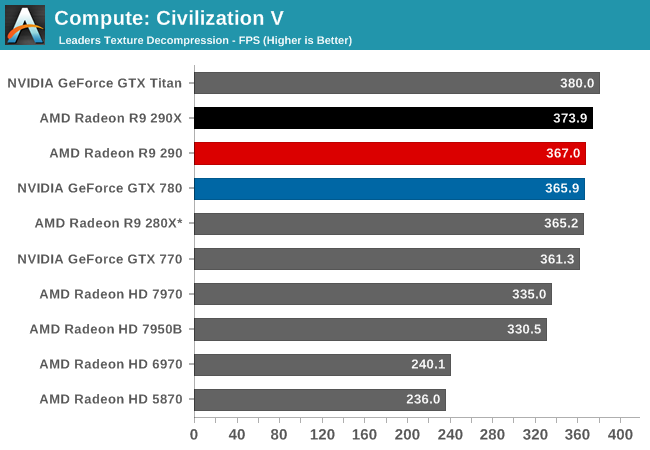
As with the 290X, Civ V can’t tell us much of value due to the fact that we’re running into CPU bottlenecks, not to mention increasingly absurd frame rates. The 290 is marginally slower than the 290X due to the lower clockspeeds and missing CUs, but minimally so.
Our next benchmark is LuxMark2.0, the official benchmark of SmallLuxGPU 2.0. SmallLuxGPU is an OpenCL accelerated ray tracer that is part of the larger LuxRender suite. Ray tracing has become a stronghold for GPUs in recent years as ray tracing maps well to GPU pipelines, allowing artists to render scenes much more quickly than with CPUs alone.
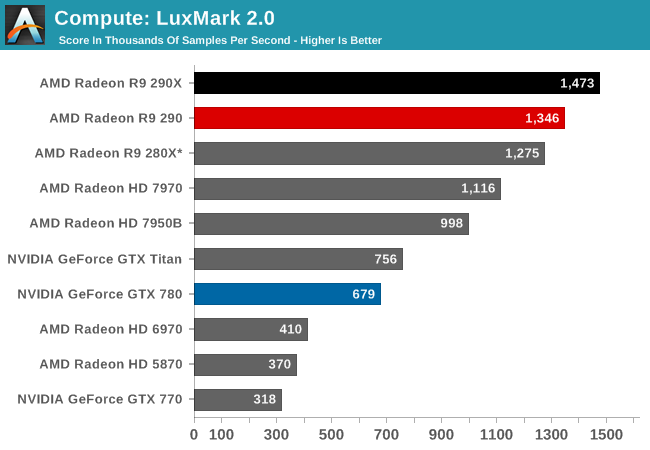
With both cards unthrottled and bound solely by shader performance, it’s an outright foot race for the Radeon cards. 290 trails 290X by around 9%, closely mirroring the difference in the CU count between the two cards. Though 290 is being very closely chased by the 280X, as Hawaii in general seems to have trouble getting the most out of its shader hardware on this benchmark.
Our 3rd compute benchmark is Sony Vegas Pro 12, an OpenGL and OpenCL video editing and authoring package. Vegas can use GPUs in a few different ways, the primary uses being to accelerate the video effects and compositing process itself, and in the video encoding step. With video encoding being increasingly offloaded to dedicated DSPs these days we’re focusing on the editing and compositing process, rendering to a low CPU overhead format (XDCAM EX). This specific test comes from Sony, and measures how long it takes to render a video.
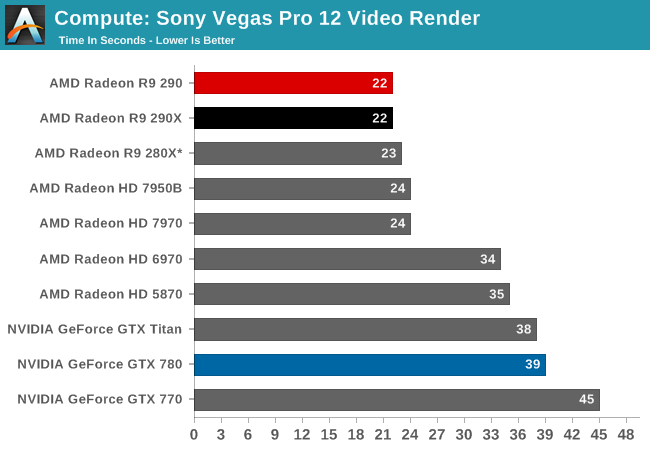
There’s not enough of a GPU performance difference between the two cards to matter with this test. Both tie at 22 seconds.
Our 4th benchmark set comes from CLBenchmark 1.1. CLBenchmark contains a number of subtests; we’re focusing on the most practical of them, the computer vision test and the fluid simulation test. The former being a useful proxy for computer imaging tasks where systems are required to parse images and identify features (e.g. humans), while fluid simulations are common in professional graphics work and games alike.
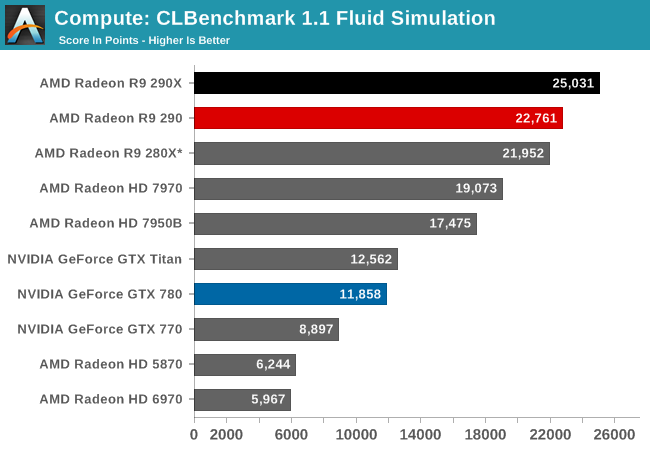

In the CLBenchmark fluid simulation the 290X and 290 take the top spots as expected, with the 290 trailing once more by 9%. However both Hawaii cards are still struggling with the computer vision benchmark, leading to the 290 being edged out by the 7970 of all things.
Moving on, our 5th compute benchmark is FAHBench, the official Folding @ Home benchmark. Folding @ Home is the popular Stanford-backed research and distributed computing initiative that has work distributed to millions of volunteer computers over the internet, each of which is responsible for a tiny slice of a protein folding simulation. FAHBench can test both single precision and double precision floating point performance, with single precision being the most useful metric for most consumer cards due to their low double precision performance. Each precision has two modes, explicit and implicit, the difference being whether water atoms are included in the simulation, which adds quite a bit of work and overhead. This is another OpenCL test, as Folding @ Home has moved exclusively to OpenCL this year with FAHCore 17.
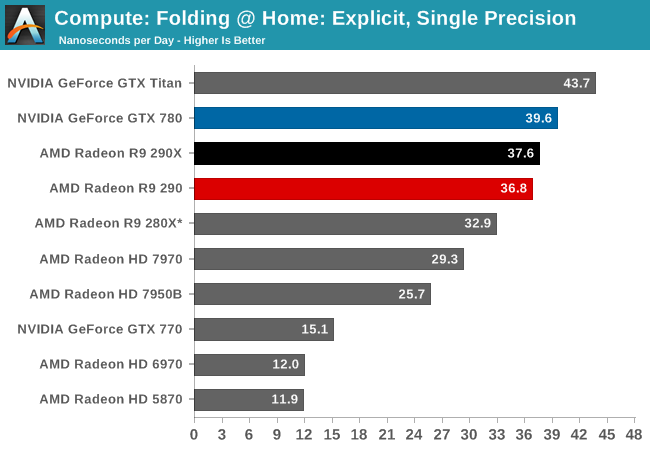
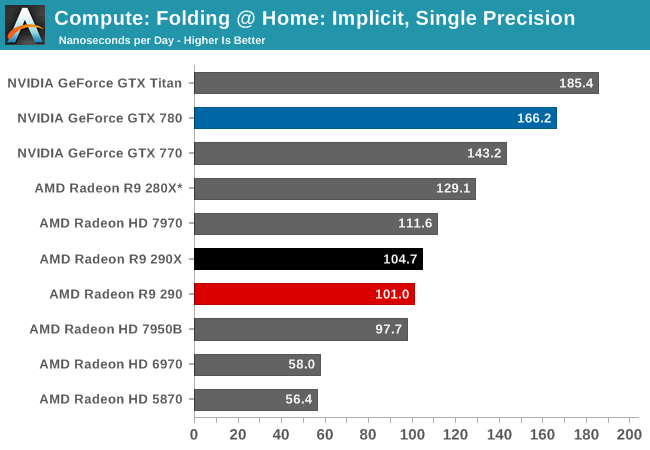
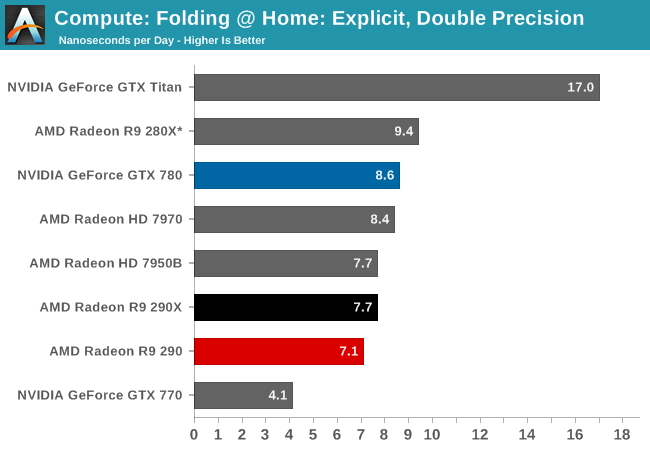
Generally Tahiti and Hawaii are strong performers in the GPU compute arena, but that isn’t of particular help to the 290 here, as it loses out to the GTX 780 in every mode. In single precision FAHBench has trouble putting Hawaii to good use at times, while double precision tests have the 1/8th DP rate 290 and 290X falling behind due to their lower than Tahiti DP throughput.
Wrapping things up, our final compute benchmark is an in-house project developed by our very own Dr. Ian Cutress. SystemCompute is our first C++ AMP benchmark, utilizing Microsoft’s simple C++ extensions to allow the easy use of GPU computing in C++ programs. SystemCompute in turn is a collection of benchmarks for several different fundamental compute algorithms, as described in this previous article, with the final score represented in points. DirectCompute is the compute backend for C++ AMP on Windows, so this forms our other DirectCompute test.
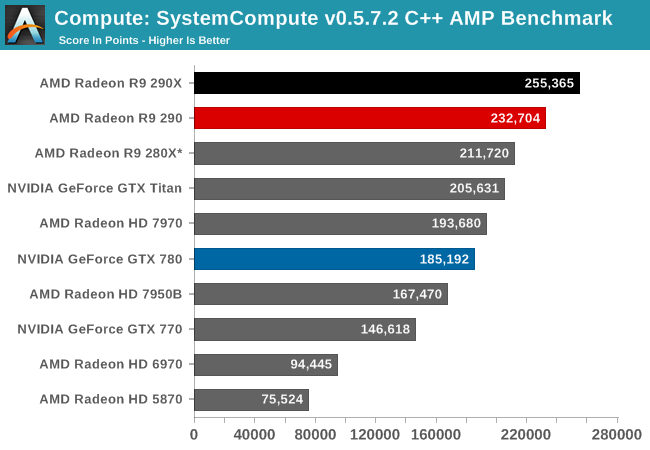
SystemCompute is another benchmark where 290 and 290X do not experience meaningful throttling, and as such are separated by more than what happens in our gaming benchmarks. In this case 290 yet again trails 290X by 9%, though it still enjoys a considerable lead over the GTX 780 and all other NVIDIA cards.










295 Comments
View All Comments
mattgmann - Tuesday, November 5, 2013 - link
I'd really like to see some benchmarks with this and the 290x under water.For someone like me that has already invested in building a water cooling setup and seen a few generations of hardware pass through it, the idea of watercooling the graphics card is a foregone conclusion.
The only added cost to me in upgrading the cooling is a few dollars worth of memory and other heatsinks to put on the card since I'd be using a universal gpu block.
I have a feeling that with the thermal levels in check, these cards will probably perform a good bit quicker than they already do (and that much more than the competition).
supamark - Tuesday, November 5, 2013 - link
"At the end of the day the 290 is 9.7dB louder than its intended competition, the GTX 780. With a 10dB difference representing a two-fold increase in noise on a human perceptual basis, the 290 is essentially twice as loud as the GTX 780."Un, no. Learn to dB... 3 dB would mean it's twice as loud, 10 dB means it's 10x as loud, the decibel is a log scale.
NomanA - Tuesday, November 5, 2013 - link
Human audio perception is also on a somewhat logarithmic scale. Twice as loud, doesn't mean, two times a certain value on a linear scale.supamark - Tuesday, November 5, 2013 - link
Sorry, but 3 dB is twice as loud. 10 dB, aka 1 Bel, is 10 times as loud. You hear 3 dB as twice as loud. You should just read this.... (3rd paragraph) instead of arguing.http://en.wikipedia.org/wiki/Decibel
kiwidude - Tuesday, November 5, 2013 - link
You are incorrect, 3dB represents a ratio of two to one or a doubling of power. Perception of loudness is not the same as sound pressure level or power. An increase of 10db SPL is perceived to be approximately twice as loud.I suggest you read instead of arguing. http://trace.wisc.edu/docs/2004-About-dB/
Sancus - Wednesday, November 6, 2013 - link
You're talking about power. Ryan Smith is talking about perceptual loudness. They're completely different. 10db does NOT sound 10 times as loud to your ear. It merely represents ten times as much power.http://trace.wisc.edu/docs/2004-About-dB/
piroroadkill - Wednesday, November 6, 2013 - link
You would need to start talking about human-hearing-weighted scales at that point to get any kind of "X as loud" to us, type measurements. Which is where dBA is often the go to scale.philosofa - Tuesday, November 5, 2013 - link
Don't quote me regulations. I co-chaired the committee that reviewed the recommendation to revise the color of the book that regulation's in. We kept it gray.Excellent editing ser :)
dudeofdur - Tuesday, November 5, 2013 - link
bracket + closed loop water cooler. Boom, solved your problemTorm - Tuesday, November 5, 2013 - link
It is sad when a review is so biased, that the reviewer doesn't appreciate extra performance. If you prefer a quiet card, turn the fan speed down. You are here to review the performance, and while the noise level is taken into consideration, in your final thoughts, you never once say "While the may be loud, you can always adjust fan levels to find the right sound for you." This card, by performance numbers, should have been a very high recommendation, with a note on it being loud. You decided in the review of the card, that you had rather recommend against it, as opposed to being honest. While I tested the card, I found it loud yes, but I also found that if I was an "Average" consumer, who will have their computer case sitting at least 2-3 feet from them, and listening to the audio of a game, movie, or music, that the audio difference between it and the 780 is barely noticed. This is a good review ruined by Biased minded comments. If you are looking for one of the best cards out there, and the BEST value for your money. This card IS it. Bar None. Just to be clear. I am a Hardcore Titan fan, but if I were to build a PC today, this would be the card I went with.